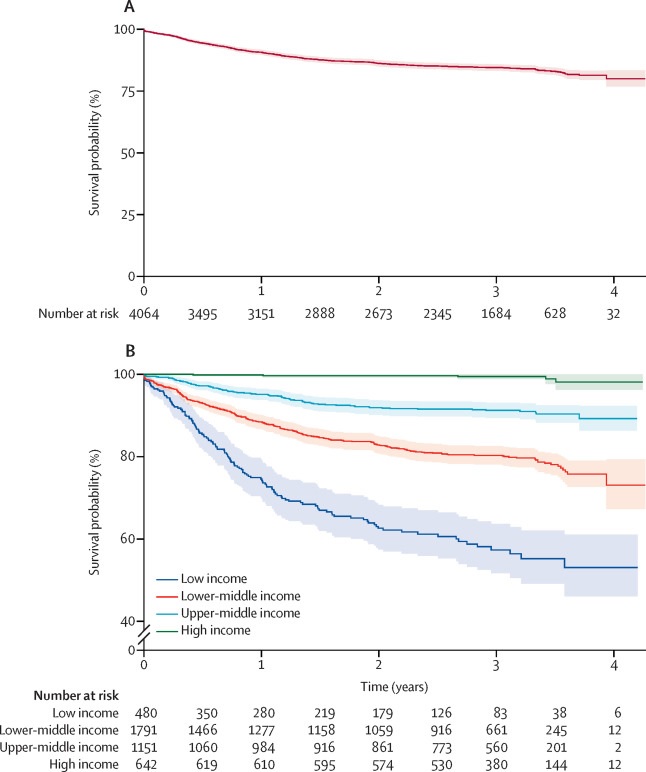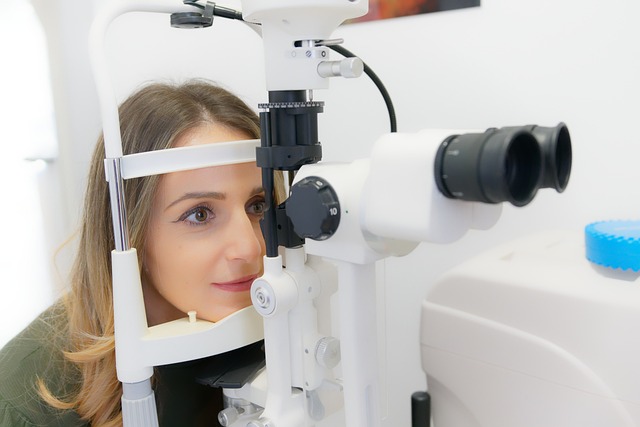Retinoblastoma is the most common cause of death from eye cancer worldwide. Early diagnosis and timely treatment can save a child’s life and eyeball, preserving useful vision in selected cases. As a rare neoplasm, data on the outcomes of retinoblastoma are scarce, especially in low- and middle-income countries.
We previously reported the clinical characteristics of a global sample of children with retinoblastoma at diagnosis, who presented to specialized treatment centers around the world in 2017.
Late presentation with advanced disease was strongly associated with the economic grouping of the country of residence. Here, we aimed to investigate 3-year outcomes in the same global cohort of children with retinoblastoma.
Background
Retinoblastoma is the most common intraocular cancer worldwide. There is some evidence to suggest that there are important differences in treatment outcomes for children with retinoblastoma from different regions, but these differences have not been evaluated on a global scale. We aimed to report 3-year outcomes for children with retinoblastoma globally and investigate factors associated with survival.
Methods
We did a prospective analysis based on groups of treatment-naive retinoblastoma patients who were diagnosed between January 1, 2017 and December 31, 2017, then treated and followed for 3 years. Patients were recruited from 260 specialized treatment centers worldwide.
Data on primary and additional treatments, duration of follow-up, metastasis, globe salvage, and survival outcome were obtained from participating centers. We analyzed time to death and time to enucleation with Cox regression models.
Results
The cohort included 4064 children from 149 countries . The median age at diagnosis was 23.2 months (IQR 11.0-36.5).
Extraocular tumor spread (cT4 of cTNMH classification) at diagnosis was reported in five (0.8%) of 636 children from high-income countries, 55 (5.4%) of 1027 children from low-income countries upper-middle-income countries, 342 (19·7%) of 1738 children from lower-middle-income countries, and 196 (42·9%) of 457 children from low-income countries.
Enucleation surgery was available for all children and intravenous chemotherapy was available for 4014 (98.8%) of 4064 children.
The 3-year survival rate was 99.5% (95% CI 98.8–100.0) for children from high-income countries, 91.2% (89.5–93.0) for children from upper-middle-income countries, 80·3% (78·3–82·3), for children from lower-middle-income countries, and 57·3% (52·1–63·0) for children from upper-middle-income countries. low income.
In the analysis, independent factors for worse survival were residence in low-income countries compared with high-income countries (hazard ratio 16.67, 95% CI 4.76–50.00), advanced tumor cT4 compared to cT1 (8.98; 4·44–18·18), and older age at diagnosis in children up to 3 years of age (1·38 per year; 1·23–1·56).
For children aged 3 to 7 years, the risk of mortality decreased slightly (p=0·0104 for slope change).

Survival analysis for the entire cohort and by income group. (A) Kaplan-Meier survival plot for the entire cohort. (B) Kaplan-Meier survival plot by income group.
Interpretation
This study, which is estimated to include approximately half of all new retinoblastoma cases worldwide in 2017, shows profound inequity in children’s survival based on the national income level of their country of residence.
In high-income countries, death from retinoblastoma is rare, while in low-income countries, the estimated 3-year survival is just over 50%.
Although essential treatments are available in almost all countries, early diagnosis and treatment in low-income countries are key to improving survival outcomes.
Discussion
This study shows that there is a large disparity in the survival rate of children with retinoblastoma depending on the economic level of their country of residence. The largest gap, a nearly 17-fold difference , was found between children from high-income countries and low-income countries. In high-income countries, retinoblastoma is considered a curable disease and death is a rare event, while in low-income countries we found that just over 50% of children with retinoblastoma were still alive 3 years after diagnosis.
At diagnosis, 40% of children in low-income countries compared with less than 1% in high-income countries had extraocular tumor spread, and children with an extraocular tumor had a nearly tenfold increased risk of dying compared to those with early intraocular disease. However, low-income status remained a significant risk factor for death, regardless of stage at diagnosis.
Variations in management options depending on the country’s income level are a possible contributing factor. Enucleation and intravenous chemotherapy, which can save a child’s life, were available in almost all centers and countries. However, we previously reported differences in the availability of sophisticated treatments and research facilities in low- and middle-income countries (such as MRI, targeted chemotherapy, radiotherapy, and focal treatments).
Another possibility is that children in low-income countries present with a more biologically aggressive form of the disease, a suggestion that emerged from the data in our presentation.
In conclusion , according to this prospective global analysis, despite the availability of potentially curative treatment modalities in almost all countries, profound inequity in retinoblastoma mortality persists. In high-income countries, almost 100% of children with retinoblastoma survive, while in low-income countries just over 50% are still alive 3 years after diagnosis, if they are brought in for treatment.
About three in 100 children with retinoblastoma still lose both eyes.
Improved awareness of the early signs of retinoblastoma, improving access to timely diagnosis, and implementation of existing treatment guidelines and recommendations targeting children in low- and middle-income countries are crucial to improving retinoblastoma outcomes worldwide. . Notably, life-saving treatment was available in almost all participating centers, regardless of country of residence.
The findings of the present study provide an evidence base for the prioritization and planning of the WHO Global Initiative for Childhood Cancer, which aims to help governments support the creation of high-quality, sustainable childhood cancer programs for improve survival and reduce suffering.
Comments
The findings suggest a striking difference in the risk of childhood death from retinoblastoma between high- and low-income countries within three years of diagnosis.
Children with the eye cancer retinoblastoma in a low-income country have a 16 times greater risk of dying at any time within three years of diagnosis than those in high-income countries, according to a new study published in The Lancet Global Health .
The research, led by the International Center for Eye Health (ICEH) at the London School of Hygiene and Tropical Medicine (LSHTM), found marked differences in the survival of children with retinoblastoma, the most common form of childhood eye cancer, between high-income people and low-income countries.
Retinoblastoma is the most common and devastating eye cancer affecting children worldwide, and early diagnosis and treatment are critical to preventing death or loss of an eye.
In high-income countries, this risk has been dramatically reduced in recent decades, and death is now rare due to robust diagnostic and treatment pathways, including specialized retinoblastoma centers.
The study, which is the largest and most geographically comprehensive on retinoblastoma to date, analyzed survival data for 4,064 children with retinoblastoma from 149 countries (classified as high-income, upper-middle, lower-middle, and low-income) at a global level. world. These are estimated to account for 50% of all new cases worldwide in 2017.
The team looked at the three-year survival rate for these children after their diagnosis and found that more than two-fifths (40%) of children die within three years of diagnosis in low-income countries, compared to less than one in 100 (1%) in high-income countries.
Professor Matthew Burton, Director of ICEH at LSHTM, said: “This is a shocking result, highlighting the inequalities between high- and low-income countries for this disease. We cannot accept that children are at such a high risk of death in low-income settings from a disease that is considered curable elsewhere. We need to ensure that the reasons for this disparity are determined and policies are enacted that close this survival gap.”
Although the study shows that the main treatments for retinoblastoma (removal of one eye or enucleation and intravenous chemotherapy) are available in all countries, several factors may be responsible for the reduced survival rate. Previous studies suggest that low-income countries are less likely to have specialized treatment centers containing sophisticated equipment and techniques, such as MRI machines and targeted chemotherapy. It is suggested that limited awareness among the general public and healthcare workers, and problems accessing treatment due to distance and cost of travel, contribute to worse outcomes and increased risk of death.
Dr Ido Didi Fabian, lead author and principal investigator of the Global Retinoblastoma Study Group at LSHTM, said: "We always knew there was a difference in outcomes between higher and lower income countries, but the differences we are Seeing in this study, the largest of its kind, are very worrying for children affected by retinoblastoma. Improved awareness of early signs, improved access to timely diagnosis and implementation of existing guidelines targeting children in low-income countries and medium are critical to improving retinoblastoma outcomes worldwide.”
The work was made possible by the Retinoblastoma Network (Rb-NET), facilitated by ICEH, which allowed 260 retinoblastoma centers around the world to share data for the study. This collective data sharing could further lead to an in vivo clinical data repository , strengthening evidence-based guidance on management of the condition.
Most of the existing evidence for retinoblastoma comes from high-income countries, even though patients in areas such as North America, Europe and Oceania account for less than 10% of global cases. The authors note that more research is needed in low-income countries themselves to identify the causes of this global disparity and improve outcomes.
The authors acknowledge limitations of the study, including that the cohort was a sample taken from a previous study (even though it contained half of all cases worldwide for that year). The study also did not collect detailed data on treatment, for example, specific treatment protocols and complications. Future studies could include these subanalyses.
Added value of this study This prospective cluster-based analysis reports the 3-year outcomes of 4064 treatment-naïve retinoblastoma patients recruited in 2017 from 149 countries, including 41 African countries. This cohort is estimated to represent approximately half of all new children diagnosed with retinoblastoma worldwide in 2017. Our findings show that in high-income countries retinoblastoma is a curable disease with almost 100% survival, while in low-income countries the 3-year survival is just over 50%. Life-saving treatments were reported to be available in almost all countries. Risk factors for this huge disparity in survival included the income level of the country of residence (low income vs. high income), extraocular retinoblastoma at diagnosis, and advanced age at diagnosis (up to age 3). years). Implications of all available evidence This study reports a huge global inequity in the prognosis of retinoblastoma in children. Provides evidence for action at national and international levels, including the WHO Global Initiative for Childhood Cancer, which aims to provide leadership and technical assistance to governments to develop high-quality childhood cancer programs to improve survival and reduce the suffering. |
















